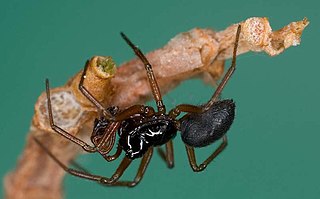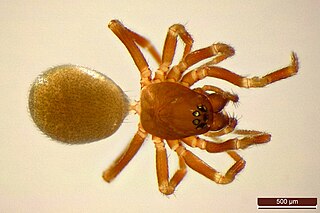
Linyphiidae, spiders commonly known as sheet weavers, or money spiders is a family of very small spiders comprising 4706 described species in 620 genera worldwide. This makes Linyphiidae the second largest family of spiders after the Salticidae. The family is poorly understood due to their small body size and wide distribution; new genera and species are still being discovered throughout the world. The newest such genus is Himalafurca from Nepal, formally described in April 2021 by Tanasevitch. Since it is so difficult to identify such tiny spiders, there are regular changes in taxonomy as species are combined or divided.

Walckenaeria is a genus of dwarf spiders that was first described by John Blackwall in 1833. It is a senior synonym of Paragonatium, as well as Wideria, Cornicularia, Prosopotheca, Tigellinus, and Trachynella.

Erigone is a genus of dwarf spiders that was first described by Jean Victoire Audouin in 1826. They are carnivorous, preying on small insects such as Psylla and flies. One of the distinctive characters for this genus is the presence of teeth bordering the carapace.

Lepthyphantes is a genus of dwarf spiders that was first described by Anton Menge in 1866.

Agyneta is a genus of dwarf spiders that was first described by J. E. Hull in 1911.
Acartauchenius is a genus of dwarf spiders that was first described by Eugène Louis Simon in 1884.

Ctenus is a genus of wandering spiders first described by Charles Athanase Walckenaer in 1805. It is widely distributed, from South America through Africa to East Asia. Little is known about the toxic potential of the genus Ctenus; however, Ctenus medius has been shown to share some toxic properties with Phoneutria nigriventer, such as proteolytic, hyaluronidase and phospholipase activities, in addition to producing hyperalgesia and edema. The venom of C. medius also interferes with the complement system in concentrations in which the venom of P. nigriventer is inactive, indicating that some species in the genus may have a medically significant venom. The venom of C. medius interferes with the complement component 3 (C3) of the complement system; it affects the central factor of the cascades of the complement, and interferes with the lytic activity of this system, which causes stronger activation and consumption of the complement components. Unlike C. medius, the venom of P. nigriventer does not interfere with lytic activity.

Araeoncus is a genus of dwarf spiders that was first described by Eugène Louis Simon in 1884. They closely resemble members of Diplocephalus; both genera have a uniquely shaped of the cephalothorax and a species-specific modification of the tibial apophysis of the pedipalp.

Centromerus is a genus of dwarf spiders that was first described by David B. Hirst in 1886.
Erigonoplus is a genus of dwarf spiders that was first described by Eugène Louis Simon in 1884.

Oedothorax is a genus of dwarf spiders that was first described by A. Förster & Philipp Bertkau in 1883.

Palliduphantes is a genus of dwarf spiders that was first described by Michael I. Saaristo & A. V. Tanasevitch in 2001.
Panamomops is a genus of dwarf spiders that was first described by Eugène Louis Simon in 1884.

Pelecopsis is a genus of dwarf spiders that was first described by Eugène Louis Simon in 1864.

Silometopus is a genus of sheet weavers that was first described by Eugène Louis Simon in 1926.

Tapinocyba is a genus of sheet weavers that was first described by Eugène Louis Simon in 1884.

Trichoncus is a genus of sheet weavers that was first described by Eugène Louis Simon in 1884.














